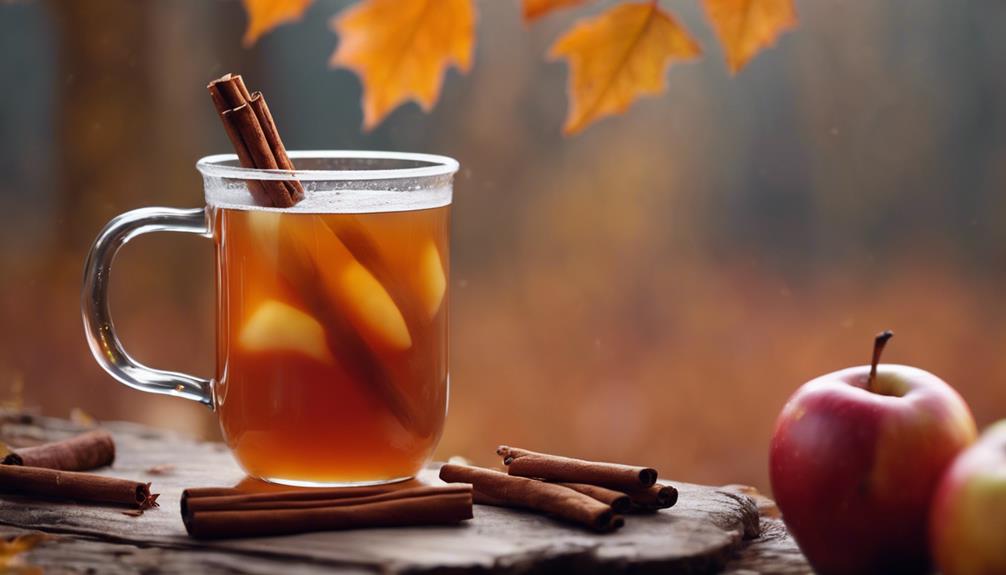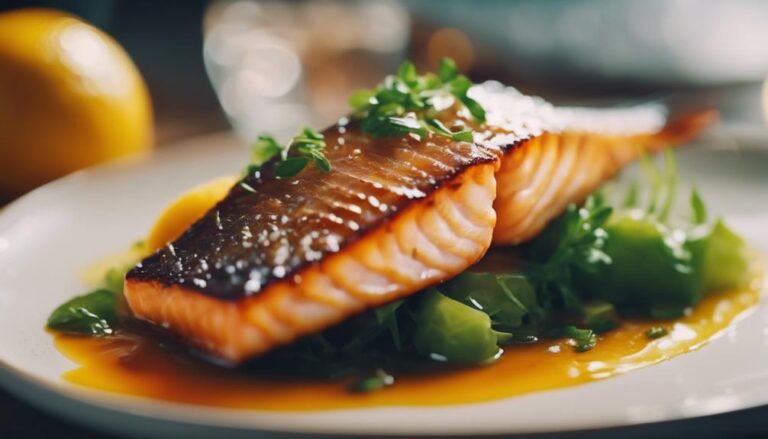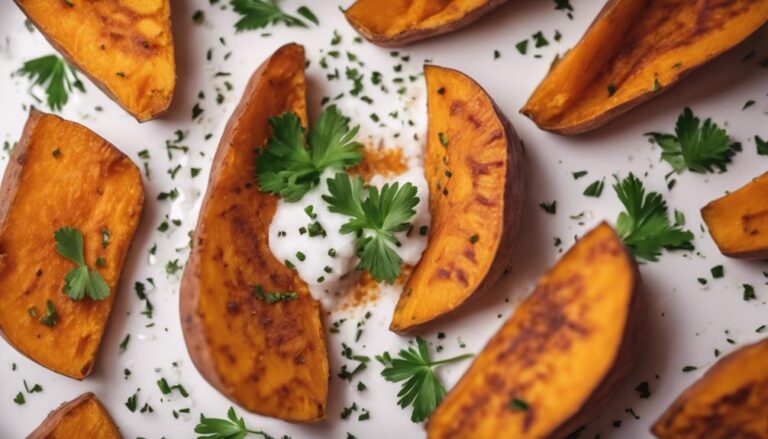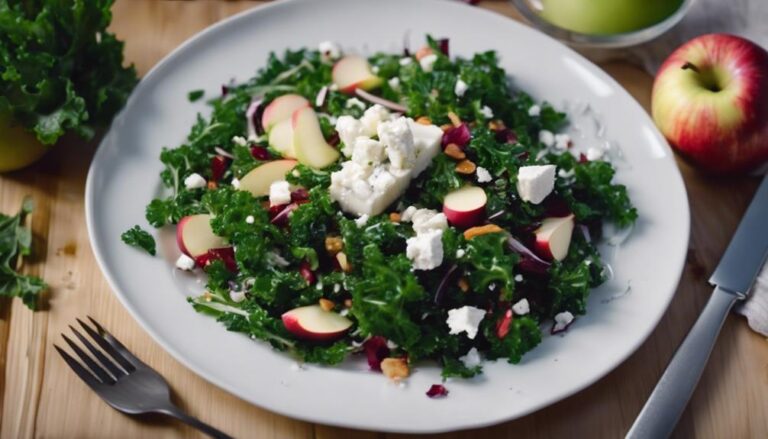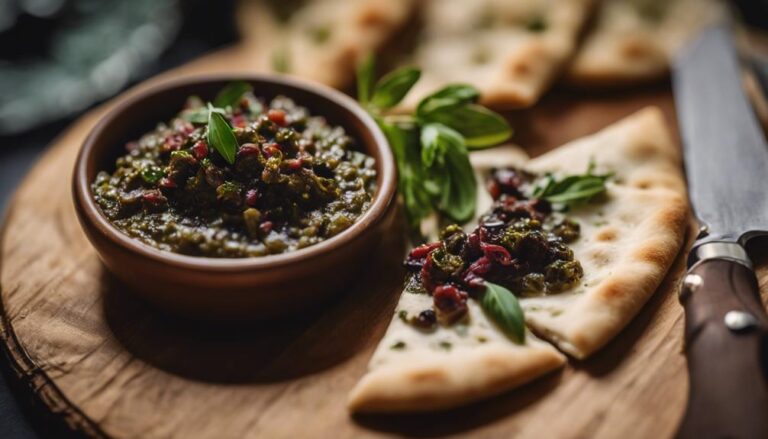Sous Vide Hot Apple Cider
To create a perfectly balanced hot apple cider, using the sous vide method is crucial. Set your sous vide to 160°F (71°C) for best flavor extraction. This technique guarantees even heating for a harmonious beverage. Sous vide preserves flavors while infusing them gently. Your cider will maintain its natural sweetness and complexity. The precise control of temperature ensures a rich taste profile. Elevate your cider experience with this method.
What You Will Learn Here
- Sous vide maintains precise temperature control for optimal flavor extraction.
- Infuses apple cider with spices gently over time for enhanced taste.
- Preserves natural sweetness of apples without risk of caramelization.
- Results in a well-balanced, complex, and robust cider profile.
- Guarantees a cleaner taste with heightened flavors in hot apple cider.
Apple Cider Origins
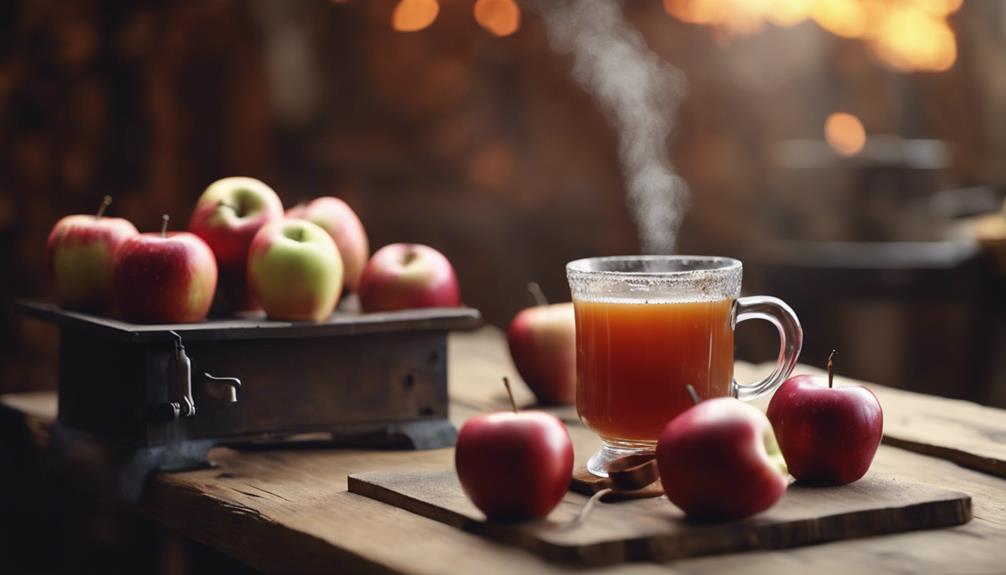
Apple cider's origins encompass a rich history steeped in agricultural traditions and fermentation processes. The evolution from ancient cider-making methods to contemporary techniques has led to a diverse array of cider varieties available today.
Understanding the historical context of apple cider production sheds light on the complexity and craftsmanship involved in every sip.
History of Apple Cider
Tracing the origins of cider production reveals a rich tapestry of agricultural and fermentation practices. Apple cider fermentation, an essential step in hard cider production, dates back thousands of years. Ancient civilizations like the Romans and Greeks were known to ferment apple juice into a rudimentary form of cider.
Over time, this process evolved, with Medieval monks refining techniques and improving the quality of cider. In colonial America, apple cider became a staple beverage due to the abundance of apple orchards. The Industrial Revolution mechanized cider production, making it more accessible to the masses.
Understanding the history of apple cider provides insight into the cultural and technological advancements that have shaped this beloved beverage.
Traditional Cider Making
Examining the traditional methods of cider making reveals a meticulous process that intertwines agricultural practices with fermentation techniques, culminating in the production of a timeless beverage.
Traditional cider making begins with selecting the finest apples, typically a mix of sweet, tart, and bittersweet varieties. The apples are washed, crushed, and pressed to extract the juice. This juice is then left to ferment, allowing natural yeasts present on the apple skins to kickstart the process.
The fermentation stage is vital, as sugars in the juice are converted into alcohol, giving cider its characteristic taste. After fermentation, the cider is often aged to develop complex flavors before bottling.
Understanding these traditional methods provides insight into the rich history and craftsmanship behind cider production.
Modern Cider Varieties
Delving into the diverse landscape of modern cider varieties reveals a fascinating evolution rooted in the historical origins of apple cultivation and fermentation techniques. When exploring the world of modern cider, two critical aspects stand out: cider fermentation and cider tasting. Below is a table showcasing some innovative modern cider varieties that highlight the intricate processes of fermentation and offer unique tasting experiences.
| Cider Variety | Fermentation Process |
|---|---|
| Sparkling Cider | Secondary fermentation in the bottle |
| Ice Cider | Concentrated apple juice fermentation |
| Hopped Cider | Infusion with hops during fermentation |
These modern cider varieties showcase the creativity and experimentation in cider making, offering a diverse range of flavors and textures for the adventurous cider enthusiast.
Apple Varieties for Cider
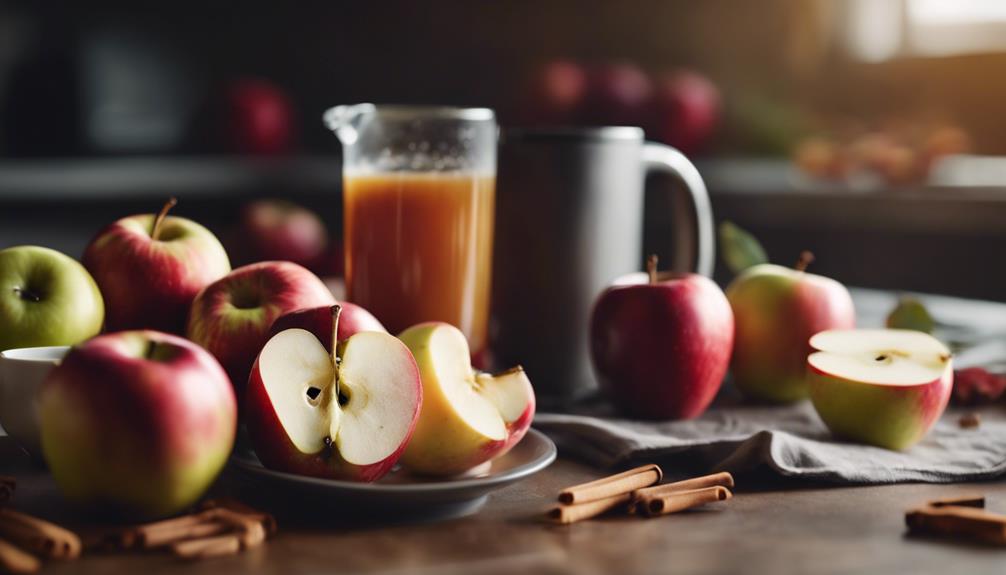
When selecting apple varieties for cider production, consider the specific attributes of each type to achieve the desired flavor profile and overall quality in the finished product.
- Taste Preferences: Different apple varieties contribute unique flavors to cider. Varieties like Kingston Black and Dabinett offer a bittersweet taste, while Ashmead's Kernel provides a nutty and aromatic flavor. For a more acidic cider, consider using varieties like Bramley's Seedling.
- Tannin Levels: Tannins are essential for mouthfeel and complexity in cider. Varieties such as Yarlington Mill and Harry Masters Jersey are known for their high tannin content, while Golden Russet offers a moderate level suitable for balancing flavors.
- Sugar Content: Apples with high sugar content, like Honeycrisp or Fuji, can increase the alcohol content of the cider. Balancing sweet varieties with tart ones, such as Granny Smith, can create a harmonious blend.
- Aromatic Compounds: Varieties like McIntosh and Winesap are rich in aromatic compounds, enhancing the overall sensory experience of the cider. Experiment with different combinations to find the perfect balance of aroma and flavor in your cider production.
Mulled Apple Cider Options
When considering mulled apple cider options, you may want to explore the aromatic blend of cinnamon-infused apple cider. This adds a warm and cozy flavor profile to your drink.
Another intriguing choice could be the spiced apple cider twist. It offers a unique combination of spices that elevate the traditional apple cider experience.
For a more adventurous twist, the apple cider sangria recipe presents a delightful fusion of apple cider with the vibrant notes of a sangria. This provides an invigorating option for those seeking a fruity and spiced beverage.
Cinnamon-Infused Apple Cider
For an aromatic twist to your apple cider, consider infusing it with cinnamon to enhance its flavor profile. Cinnamon adds warmth and depth to the cider, making it a perfect choice for a cozy night in or a festive gathering.
Here are some innovative ways to enjoy your cinnamon-infused apple cider:
- Cinnamon Sticks: Add whole cinnamon sticks to the cider while simmering to release their essential oils gradually.
- Cinnamon Sugar Rim: Dip the rim of your serving glass in cinnamon sugar for a sweet and spicy kick with every sip.
- Cinnamon Spice Blend: Create a custom cinnamon spice blend with nutmeg, cloves, and allspice for a more complex flavor profile.
- Cinnamon Whipped Cream: Top your cider with cinnamon-infused whipped cream for a luxurious treat.
Experiment with these ideas to elevate your apple cider experience.
Spiced Apple Cider Twist
Consider infusing your apple cider with a variety of spices to create a flavorful and aromatic twist that will elevate your drinking experience. Spiced cider cocktails can be taken to the next level with the addition of a well-balanced blend of cinnamon, cloves, nutmeg, and allspice. These spices not only add warmth and depth to the cider but also create a symphony of flavors that dance on your taste buds.
When paired with freshly baked apple cider donuts, the experience is truly indulgent. The combination of the spiced cider's richness and the sweet, pillowy texture of the donuts creates a sensory explosion that's perfect for cozy evenings or festive gatherings.
Apple Cider Sangria Recipe
To enhance the flavor profile of your apple cider, exploring the Apple Cider Sangria Recipe can provide a delightful twist with mulled apple cider options. When considering fall cocktail ideas, Sangria variations can offer an invigorating take on traditional apple cider. Here are some innovative ways to elevate your Apple Cider Sangria:
- Incorporate seasonal fruits like pears and cranberries for added complexity.
- Experiment with different types of apples to find the perfect balance of sweetness and acidity.
- Add a cinnamon stick or star anise to infuse warm, aromatic notes into the sangria.
- Consider using a splash of brandy or rum to enhance the depth of flavors in your drink.
Cider Heating Techniques
When heating cider, consider utilizing different techniques such as sous vide, the traditional stovetop method, or a slow cooker for a variety of results.
Sous vide provides precise temperature control, ensuring the cider's flavors are preserved.
The stovetop method offers a quick way to heat cider, while a slow cooker allows for a longer, more hands-off approach to gently warm the beverage.
Heating Cider Sous Vide
How precisely can you set the temperature when heating cider sous vide to achieve ideal flavor extraction and consistency in the final beverage?
When using the sous vide technique for heating cider, maintaining a critical temperature is vital for extracting the desired infusion flavors while preserving the natural essence of the ingredients.
The sous vide temperature should be set at around 160°F (71°C) for apple cider to allow the flavors to meld without compromising the freshness of the ingredients.
This controlled heating method guarantees a consistent distribution of heat throughout the cider, resulting in a well-balanced and flavorful beverage.
Traditional Stovetop Method
For precise control over the heating process of cider, the traditional stovetop method offers a direct and hands-on approach that allows for immediate adjustments to temperature and flavor development.
When heating cider on the stovetop, you have the advantage of closely monitoring the cider fermentation process. By heating the cider in a pot over the stove, you can observe changes in color and consistency, which are essential indicators of the cider's readiness.
In comparison to sous vide heating, the stovetop method provides a more interactive experience, allowing you to adjust the heat levels promptly to achieve the desired flavor profile. This method also enables you to stir the cider continuously, promoting even heat distribution and enhancing the overall cider infusion process.
Slow Cooker Alternative
To explore an alternative method for heating cider, consider utilizing a slow cooker as a convenient and efficient option for achieving consistent temperature control and flavor extraction.
Slow cookers, also known as crock-pots, maintain a steady low temperature over an extended period, allowing the flavors in the cider to meld together harmoniously. This method is particularly useful when you want to infuse the cider with spices like cinnamon, cloves, or star anise for a more robust taste profile.
The slow cooker's gentle heat guarantees that the cider doesn't scorch or boil over, resulting in a perfectly mulled beverage. Additionally, using a slow cooker frees up your stovetop for other cooking tasks, making it a practical choice for busy days.
If you prefer a faster option, you can also utilize an Instant Pot or even a microwave for heating your cider.
Final Thoughts
In considering the overall results of the sous vide hot apple cider preparation, it's evident that the method greatly enhances the depth of flavor and aroma in the final product. Reflections on taste comparisons between traditionally prepared apple cider and the sous vide method reveal distinct advantages in the latter. The precise temperature control in sous vide cooking allows for best extraction of flavors from the ingredients, resulting in a more robust and well-balanced cider.
The sous vide technique guarantees that the apples are gently infused with spices over an extended period, allowing for a more thorough melding of flavors. This method also maintains the natural sweetness of the apples without the risk of caramelization that can occur in traditional stovetop preparations. As a result, the sous vide hot apple cider boasts a cleaner taste profile with heightened complexity.
Frequently Asked Questions
Can Sous Vide Apple Cider Be Made Without a Vacuum Sealer?
You can make sous vide apple cider without a vacuum sealer. Alternative methods like using a zip-top bag work. Achieve flavor infusion and precise temperature control by ensuring the bag is properly sealed to maintain consistency during the cooking process.
Is It Possible to Add Alcohol to the Sous Vide Apple Cider?
Yes, you can enhance your sous vide apple cider by carefully adding alcohol for an infusion. Maintaining precise temperature control is important to prevent alcohol evaporation. Balancing flavors is key to achieving a harmonious blend of cider and alcohol.
How Long Can Sous Vide Apple Cider Be Stored?
When considering storage recommendations for sous vide apple cider, it's important to understand the impact on shelf life. Utilize preservation methods like refrigeration or freezing to extend longevity, ensuring peak quality for later consumption.
Can I Use Frozen Apples to Make Sous Vide Apple Cider?
When making sous vide apple cider, fresh apples offer a brighter, more vibrant flavor profile compared to using frozen apples. Fresh apples provide a crisp taste that can enhance the overall complexity and depth of your cider.
Are There Any Alternative Sweeteners for Sous Vide Apple Cider?
When looking for natural alternatives to sweeten your dishes, consider options like honey, maple syrup, or stevia. These choices not only provide sweetness but also offer potential health benefits such as antioxidants and lower glycemic indexes.
Conclusion
To sum up, sous vide hot apple cider offers a precise and consistent way to infuse flavors and aromas into this traditional beverage. By controlling the temperature and time, the apples' natural sweetness and spices can be enhanced to create a deliciously balanced drink.
This method allows for a more efficient extraction of flavors compared to traditional stovetop methods, resulting in a rich and satisfying apple cider experience.
Cheers to the perfect cup of warmth and flavor!
